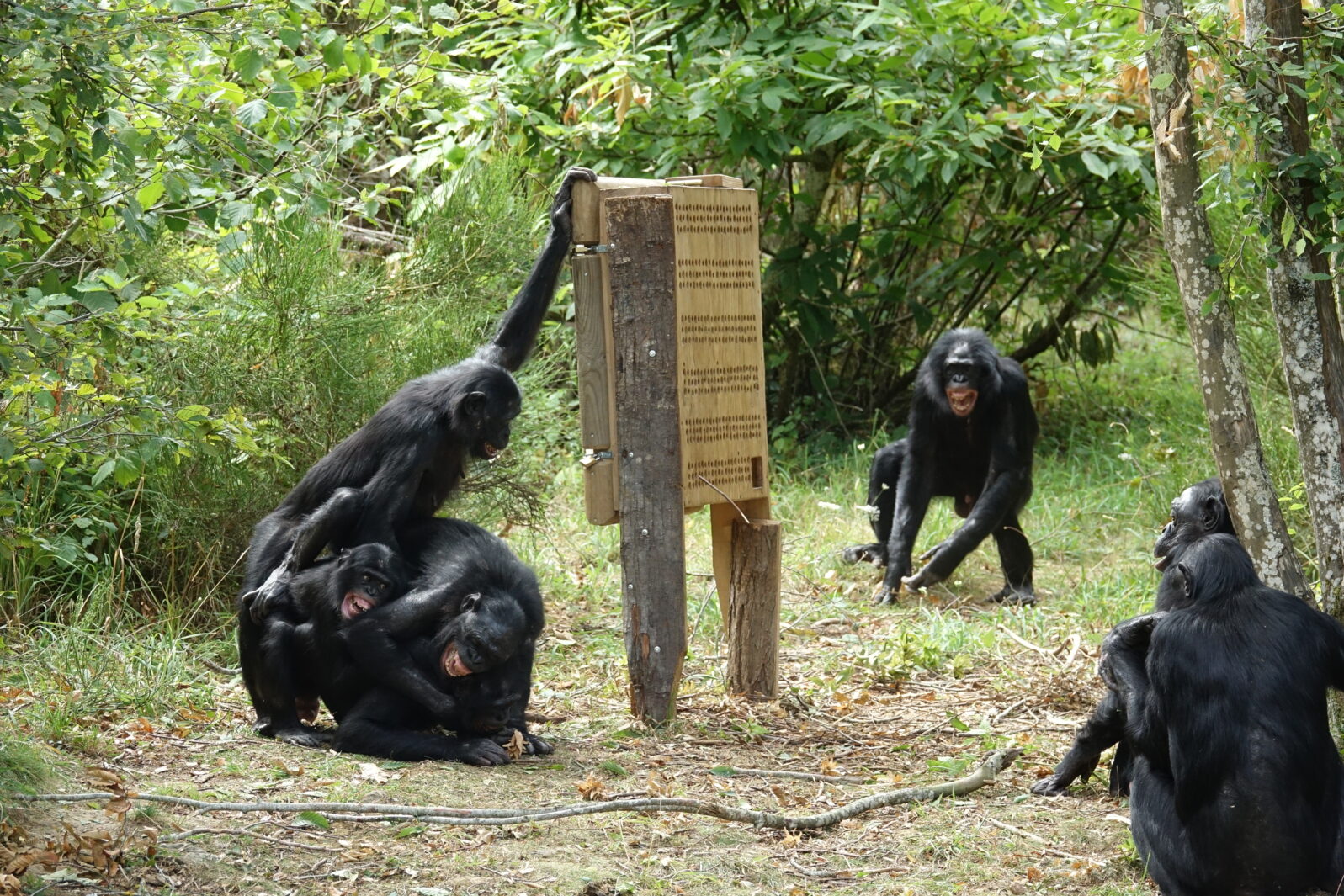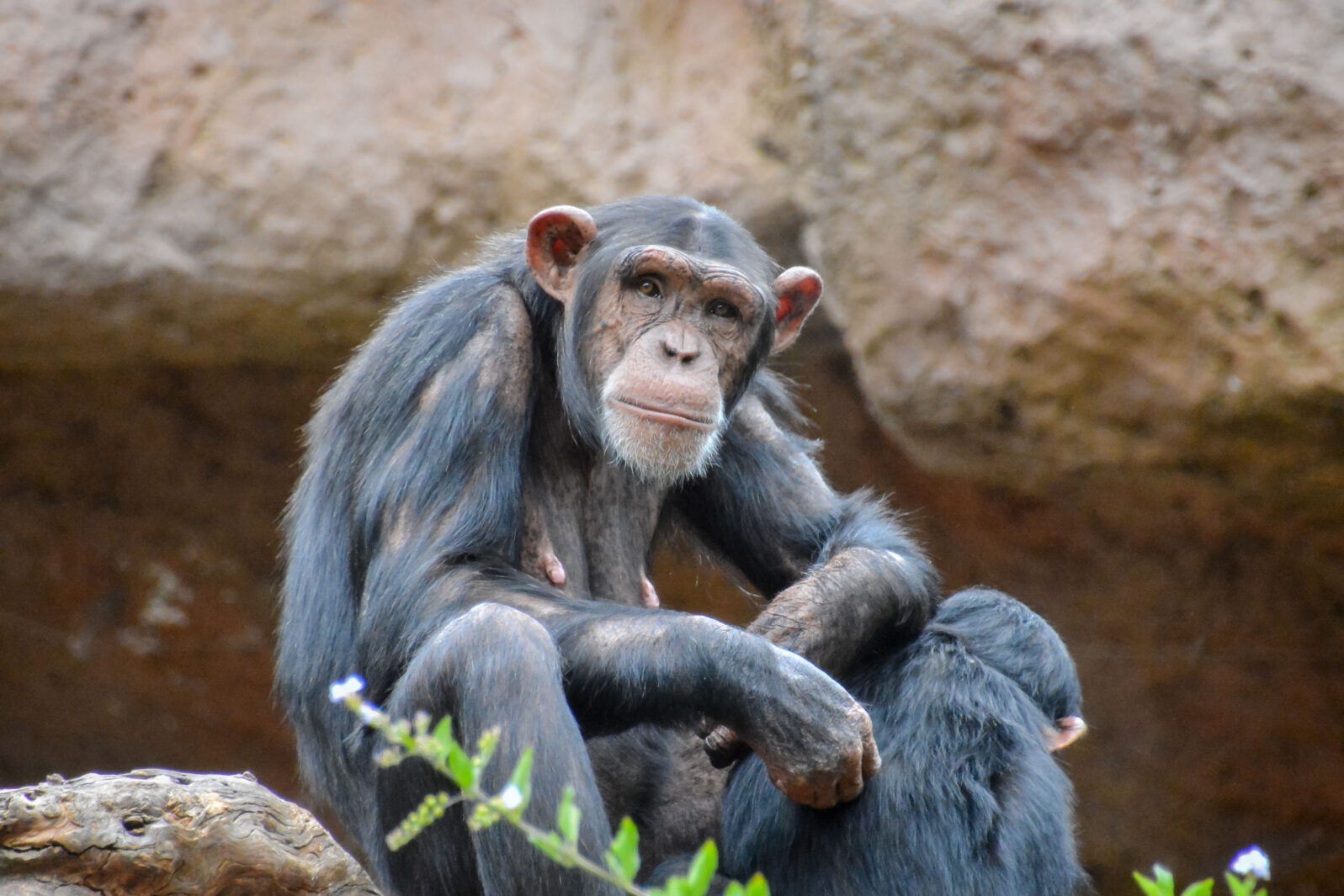But, in the End, Did the Chimpanzee Really Talk?
A recent article in the Smithsonian Magazine sheds light on the motivations behind the need to see bonobos as something like an oppressed people, rather than apes in need of protectionRecently, Michael Egnor commented on radical primatologist Sue Savage-Rumbaugh’s effort to level the playing field between humans and bonobos by including the latter as authors of a research paper on animal welfare: “Non-human animals don’t have abstract knowledge-making and practices that would allow them to be meaningfully consulted. It is reality, not anthropocentric bias, that has left animals out of this decision-making process.”

There is a larger and very interesting story around that paper, recently relayed at Smithsonian Magazine by Lindsay Stern (right), a PhD candidate in comparative literature at Yale and author of a novel, The Study of Animal Languages.
Her article tells us a good deal about the motivations of those who, essentially, see bonobos not as apes in need of protection but, to judge from their rhetoric, as something like an oppressed people.
In 2005, Savage-Rumbaugh and collaborators brought three bonobo apes to join an existing group of five at the Great Ape Trust in Desmoines, Iowa, an innovative primate research center designed to encourage intellectual activity. It included a means of communication with humans:
But the center’s signature feature was the keyboard of pictorial symbols accessible on computerized touchscreens and packets placed in every room and even printed on researchers’ T-shirts. It consisted of more than 300 “lexigrams” corresponding to English words—a lingua franca that Savage-Rumbaugh had developed over many years to enable the bonobos to communicate with human beings.
Lindsay Stern, “What can bonobos teach us about the nature of language?” at Smithsonian Magazine (July 2020)
Over three decades and more, Savage-Rumbaugh (below right) has done much to bring the clever primate’s abilities to public attention (seven books and 170 research papers). Hers has been a costly mission: When Stern met Savage-Rumbaugh, she saw that “Half of her right forefinger was missing: bitten off, she later said, by a frightened chimp she’d met in graduate school.”

Savage-Rumbaugh’s special project had been Kanzi, a bonobo who showed remarkable skill with the lexigram board. Time Magazine named her one of the world’s 100 most influential people in 2011 on account of her work with Kanzi, among other bonobos. So clearly, great things were expected. And, as Stern also notes, eminent primatologist Frans de Waal praised Savage-Rumbaugh’s research because it “punched holes in the wall” between humans and apes by showing that human language is not unique. He seems to have taken a different view later but read on.
Remarkably, in 2013, the Trust fired Savage-Rumbaugh, despite her worldwide acclaim. But she continued to live at the cottage she had rented next door to the bonobos at the facility and Stern got a chance to interview her in Des Moines.
In the interview, Savage-Rumbaugh was clear about her assumptions and goals:
“Experimental psychologists typically assume that there is a major difference between ourselves and apes that is not attributable to environmental factors,” she said. “The difference in my work is that I never made that assumption.”
Lindsay Stern, “What can bonobos teach us about the nature of language?” at Smithsonian Magazine (July 2020)
Savage-Rumbaugh and Stern wonder: “Can an animal develop a human mind?” Could living with humans transform the animal’s brain?
It’s a question you don’t ask,” Savage-Rumbaugh said. “A lot of people, a lot of scientists, don’t want that kind of study done. Because if the answer were yes…” Her eyes sparkled. “Then, oh my god—who are we?
Lindsay Stern, “What can bonobos teach us about the nature of language?” at Smithsonian Magazine (July 2020)
Certainly, Savage-Rumbaugh thought she had found evidence for such a transformation in in Kanji:
She expanded the lexigram keyboard to 256 symbols, adding novel words for places, things and activities that seemed to interest him, such as “lookout point,” “hide” and “surprise.” Rather than engage him in structured training sessions, she began using the lexigrams with him continually throughout the day, labeling objects and places all over the 55-acre property and recording what he “said” while out exploring. Seventeen months later, the young bonobo had acquired a vocabulary of 50 words. One study in 1986 showed that more than 80 percent of his multi-word statements were spontaneous, suggesting that he was not “aping” the gestures of humans but was using the symbols to express internal states of mind.
Lindsay Stern, “What can bonobos teach us about the nature of language?” at Smithsonian Magazine (July 2020)
But it did not seem to happen for bonobos who did not live with Savage-Rumbaugh in a “‘Pan/Homo’ culture” where it could more easily be observed by others:
While outsiders perceived the apes’ vocalizations as inarticulate peeps, the human members of this “culture” began to hear them as words. Acoustic analyses of the bonobos’ vocalizations suggested that the people weren’t hearing things: The vocalizations varied systematically depending on which lexigram the bonobo was pressing. In effect, the apes were manipulating their vocalizations into a form of speech.
Lindsay Stern, “What can bonobos teach us about the nature of language?” at Smithsonian Magazine (July 2020)
Who was right? More to the point, why was this momentous event only happening at the Great Ape Trust?
But, moving on, Stern tells us, Savage-Rumbaugh later decided that “ the apes’ autonomy at the Iowa facility was a sham” anyway. The bonobos were captives but she was free and was “complicit” in their captivity.
Unable to return the bonobos to the Congo, she decided to author a paper in an animal welfare journal, attacking primatologists and listing three bonobos as coauthors. Stern tells us that it did not go over well, even among primatologists who emphatically agreed on the intelligence of bonobos. Anthropologist emerita Barbara King likely spoke for many when she said, “I think we need to acknowledge that they are keenly intelligent animals without forcing them to be what they are not—capable of discussing these issues.”

After Savage-Rumbaugh was terminated, amid contested allegations that she mistreated staff and was unfit to care for the apes, a former student and co-author, Jared Taglialatela, took over, with Savage-Rumbaugh’s approval. She hoped he would establish whether the apes “would teach these behaviors to their offspring, thereby exhibiting an aptitude for cultural transmission thought unique to humankind.” But he did not do that. He did not live with the apes and studied them only in conventional ways accepted in the discipline.
In his view, Stern tells us, Savage-Rumbaugh’s experiment was “unethical”: “I think that the detriment to the individual animal is not justified by the benefit you get from the science.” But surely his approach implies that the many remarkable things the bonobos were supposed to have done in the presence of their human co-residents may have been a work of the human imagination. Not that he would come right out and say so, to be sure… Savage-Rumbaugh tried legal action but to no avail.
Franz de Waal, earlier an admirer, wrote Stern a cautious email about the case:
“Work with Kanzi has always lived somewhere between rigorous science and social closeness and family life,” he wrote. “Some scientists would like us to test animals as if they are little machines of which we only need to probe the responses, whereas others argue that apes reveal their full mental capacities only in the sort of environment that we also provide for our children, with intellectual encouragement among loving adults. There is some real tension between these two views, because loving adults customarily overestimate what their charges are capable of and throw in their own interpretations, which is why children need to be tested by neutral psychologists and not the parents. For Kanzi, too, we need this middle ground between him feeling at ease with those around him and being tested in the most objective way. The conflict around Kanzi’s custody is a fight between both sides in this debate.”
Lindsay Stern, “What can bonobos teach us about the nature of language?” at Smithsonian Magazine (July 2020)
Is that not a diplomatic way of saying that much of the apes’ human-like cognition was likely a work of the human imagination of their caretakers? If Stern suspects so, she doesn’t say. But it is a point that seems to be danced around throughout the piece.
At any rate, when Stern met Kanji at last in July 2019 at the renamed Ape Initiative, Taglialatela described his research on bonobos’ lexigram use as “promising.” Not momentous, just promising. And when Stern meets Kanji at last, nothing spectacular happens:
Heart pounding, I called out, “Hi Kanzi.” I held up the lexigrams and touched the symbol for “keyboard.”
Kanzi turned away from me and knuckled into the greenhouse, but not before pausing to punch the glass in front of my face.
My cheeks burned. What had I expected? That Kanzi would say something to vindicate either Taglialatela or Savage-Rumbaugh? That, by speaking with me, he would solve the mystery of how “human” he was?
Lindsay Stern, “What can bonobos teach us about the nature of language?” at Smithsonian Magazine (July 2020)
Stern blames herself for presumption and draws no conclusions. She goes to visit Savage-Rumbaugh, now living in Missouri and learns something of note about the fundamental ideas underlying her project:
“Our relationship to nonhuman apes is a complex thing,” she’d said. “We define humanness mostly by what other beings, typically apes, are not. So we’ve always thought apes were not this, not this, not this. We are special. And it’s kind of a need humans have—to feel like we are special.” She went on, “Science has challenged that. With Darwinian theory, this idea that we were special because God created us specially had to be put aside. And so language became, in a way, the replacement for religion. We’re special because we have this ability to speak, and we can create these imagined worlds. So linguists and other scientists put these protective boundaries around language, because we as a species feel this need to be unique. And I’m not opposed to that. I just happened to find out it wasn’t true.”
Lindsay Stern, “What can bonobos teach us about the nature of language?” at Smithsonian Magazine (July 2020)
But really, wasn’t it true? The story reminds one of the dolphin cult of the 1960s, which proved much easier on Carl Sagan (1934–1996) and Frank Drake than it did on the dolphins.
Just what bonobos can teach us about the nature of language is far from clear. But we have certainly learned a bit about what some humans need to believe and why.
Further reading:
Can animal minds rival humans under the right circumstances? Are we just not being fair to animals, as some researchers think? Including apes as co-authors on a primatology research paper created quite a stir—among humans. The apes didn’t care.
Researchers: Apes are just like us! And we’re not doing the right things to make them start behaving that way…
and
Dolphinese: The idea that animals think as we do dies hard. But first it can lead us down strange paths.
